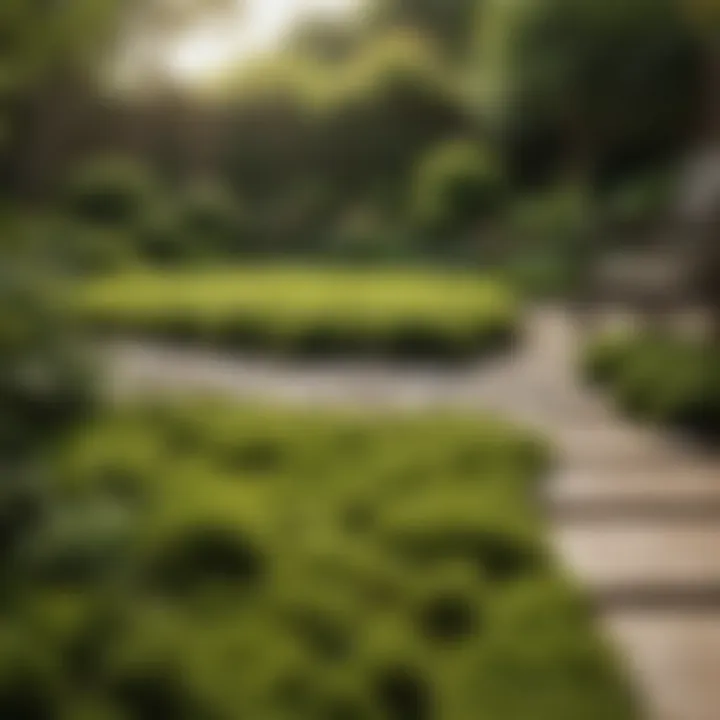Effective Home Remedies to Eliminate Moss


Intro
Moss can pose a significant challenge to those looking to maintain an attractive garden and clean outdoor surfaces. Its dense green patches, while often perceived as natural beauty, can lead to slippery surfaces and an unkempt appearance. Homeowners frequently search for remedies that are both effective and environmentally friendly. In this exploration, we delve into various home remedies that can combat moss effectively. By understanding these methods, individuals can take actionable steps to reclaim their outdoor spaces and enhance their overall environment.
Design Inspiration
While the subject primarily focuses on remedies, it's worth noting that the approach to controlling moss can influence the aesthetic of a garden or outdoor area. By integrating moss control methods into a broader design strategy, homeowners can prevent future issues and create an inviting outdoor space.
Trending Styles
The landscaping style one chooses can play a role in how moss is addressed. Modern gardens tend to favor clean lines and organized designs, which can help reduce moss growth by facilitating better air circulation. Utilizing gravel or other dry materials can also discourage moss from establishing itself. Additionally, consider incorporating raised beds or containers as they limit moss exposure to damp soils commonly found in traditional garden designs.
Color Palettes
In terms of color, vibrant and contrasting flowers can immediately draw attention away from areas affected by moss. Bright yellows, deep purples, or rich reds can work to enhance the overall visual appeal of your garden, making moss less noticeable. Choosing plants that thrive in the same conditions where moss might grow can also reduce the likelihood of moss returning, as they can compete for nutrients and moisture.
Practical Tips
Maintenance & Care
Effective moss management requires regular attention. Maintaining a healthy garden ecosystem is vital and can include:
- Regularly mowing grass to an appropriate height to enable better sunlight penetration.
- Pruning trees or hedges to improve air circulation.
- Ensuring drainage systems function optimally to prevent water accumulation.
These practices not only inhibit moss growth but also contribute to the overall health of your garden.
Budgeting & Planning
Implementing home remedies can be done on various budgets. For those with limited finances, vinegar solutions or baking soda combined with water can serve as effective alternatives. The commitment to regular care does require some planning but can ultimately lead to sustainable results. Prioritize a seasonal approach, treating moss after heavy rains or in humid months for the best effect.
"Regular maintenance and clever planning can significantly decrease the likelihood of moss resurgence."
By integrating simple practices into your routine, you can maintain a beautiful outdoor space while eliminating moss effectively.
Understanding Moss
Moss may seem trivial, but it holds significant implications for gardens, lawns, and the aesthetics of outdoor spaces. Understanding moss is the first step in managing it effectively. Moss is often seen as a nuisance; however, it provides certain ecological benefits. For instance, it helps retain moisture in the soil and can contribute to soil formation. Yet, when it overgrows in gardens or on surfaces, it can smother other plants and become uninviting.
What Is Moss?
Moss is a small, non-vascular plant that belongs to the bryophyte group. It thrives in damp and shady conditions, which makes it common in various parts of the world. Moss does not have a root system like traditional plants. Instead, it absorbs water and nutrients through its leaves. This unique structure allows moss to survive in areas where other plants might struggle. While it can add a lush greenery to landscapes, excessive growth can highlight underlying problems in soil and drainage.
Common Types of Moss
There are several types of moss that homeowners should recognize:
- Sphagnum Moss: Often used in gardening, it retains moisture well. It’s popular in potting mixes and for ornamental uses.
- Sheet Moss: This type forms a dense carpet and is frequently seen in shady areas of lawns.
- Rock Moss: Found on stones and hard surfaces, it can create interesting textures but can also lead to slippery conditions.
- Cushion Moss: This moss grows in clumps, often found in forests. It’s appealing visually but can become invasive.
Familiarity with these common types of moss can help in identifying and tackling the specific growth in your spaces.
Causes of Moss Growth
Moss thrives under particular conditions, which can lead to its proliferation in your garden or on other surfaces. Key factors contributing to moss growth include:
- Excessive Moisture: Areas that do not drain well can create a perfect habitat for moss.
- Poor Sunlight: Shady locations, often beneath trees, inhibit growth of larger plants and allow moss to dominate.
- Acidic Soil: Moss prefers slightly acidic environments, so soil pH can influence its expansion.
- Compacted Soil: Heavy foot traffic can compact the soil, allowing for less drainage and providing ideal conditions for moss.
- Debris Accumulation: Leaves and organic matter can retain moisture, leading to increased moss growth.


Identifying these contributing factors is crucial for managing moss effectively. Homeowners should consider adjusting their environments to minimize these growth conditions.
Evaluating Home Remedies
Understanding how to effectively combat moss requires a careful evaluation of various home remedies. This section aims to highlight the significance of utilizing home-based solutions and offer insights on the strengths and weaknesses of these methods. Each remedy's practicality, safety, and environmental impact will be discussed to ensure homeowners can make informed choices. This evaluation sets the stage for a deeper dive into specific home remedies, where their applications will become clearer and more suited to individual circumstances.
Benefits of Home Remedies
Home remedies for moss control are appealing for several reasons. Firstly, they often rely on common household items, making them both accessible and cost-effective. Products like vinegar, baking soda, and salt can be found in most kitchens, promising a straightforward approach to tackling moss without heavy financial investment.
Secondly, many home remedies are considered environmentally friendly, reducing the need for harsh chemicals. Such methods minimize risks associated with conventional pesticides, promoting a healthier ecosystem in gardens and outdoor spaces. Using eco-friendly solutions aligns with a growing trend among homeowners to seek sustainable gardening practices.
Furthermore, home remedies can be readily customizable. Homeowners can adjust concentrations or combine different elements based on the severity of the moss problem. This adaptability enhances the overall effectiveness, allowing for tailored solutions that sit within a broader strategy for garden maintenance.
However, while the benefits are substantial, account for the variability in results. Effectiveness can depend on moss type, growth conditions, and application methods, which brings us to consider the limitations.
Limitations to Consider
Despite the advantages of home remedies, they are not without their limitations. One primary concern is that these solutions might not achieve immediate or complete eradication of moss. In fact, some remedies may require repeated applications over time to ensure success. This factor can be discouraging for those seeking quick results.
Additionally, the effectiveness can vary significantly between different environments. For instance, factors such as light levels, moisture, and soil type contribute to how well a remedy functions. Homeowners might find that what works excellently in one area may fall short in another.
There is also the possibility of unintentional harm to desired plants. Overusing certain substances, like salt or vinegar, can lead to soil degradation or damage to nearby vegetation, thus necessitating caution in their use.
In summary, while home remedies offer a convenient and eco-friendly approach to moss control, one must navigate their limitations carefully. A thorough evaluation ensures a strategic application to maintain balance in your outdoor spaces.
Considering these factors equips homeowners with the knowledge to move forward. The next sections will provide specific home remedies that balance these benefits and limitations effectively.
Common Home Remedies
Home remedies offer an accessible and often cost-effective way to tackle moss growth. They allow homeowners to manage moss without relying solely on commercial chemicals, which can sometimes have negative environmental impacts. Understanding these remedies is essential because they not only eliminate moss but also often utilize ingredients already available at home. In addition, choosing natural solutions often aligns with the desire for eco-friendliness while addressing maintenance needs in gardens and yards.
Vinegar Solutions
Using White Vinegar
White vinegar is a common household item that has gained popularity as a natural weed and moss killer. Its high acidity levels, typically around 5%, make it detrimental to moss. Applying white vinegar directly onto moss patches can effectively kill the plants by disrupting their cellular structure. Its affordability and availability at local grocery stores contribute to its appeal. However, users should be cautious as spilled vinegar can affect nearby plants. Thus, precision in application is vital.
Using Apple Cider Vinegar
Apple cider vinegar shares similar properties with white vinegar but has a slightly different composition. With beneficial bacteria and additional nutrients, it not only kills moss but may also contribute to soil health. Homeowners often prefer apple cider vinegar for its perceived added benefits. It can be applied in the same way as white vinegar, making it an excellent alternative. However, its sweetness may attract pests, which could be a consideration, especially in warmer months.
Baking Soda Applications
Creating a Baking Soda Paste
Baking soda is another versatile household item that can be used against moss. Creating a paste by mixing baking soda with water allows for targeted application. The sodium bicarbonate in baking soda disrupts the moss’s need for certain nutrients, leading to its death. This method is often seen as a safer option than chemical alternatives, making it suitable for use in areas close to desirable plants. The disadvantage is its slower action compared to more acidic remedies, requiring patience from users.
When to Use Baking Soda
Identifying the right time to apply baking soda is crucial for effectiveness. Early spring and late fall are usually optimal, as moss grows more during these seasons. The baking soda can be spread liberally over affected areas, where it will begin to take effect after several days. This method is popular for its ease of use and low cost. Some may find that over time, repeated applications may be necessary for continued control, but it remains a favored choice among eco-conscious gardeners.
Salt as a Natural Control
Salt is often overlooked but can be an effective moss killer. Its ability to absorb moisture can lead to dehydration in moss. However, applying salt must be done with caution. Salt can contaminate soil and affect surrounding vegetation, rendering it a less desirable long-term solution. Homeowners seeking an immediate fix may find salt appealing, but they must consider the potential long-term damage to soil health.


Dish Soap and Water Mixtures
A mixture of dish soap and water can enhance the effectiveness of many moss-removing techniques. The soap helps to break the surface tension of water, allowing it to penetrate more effectively. This mixture can be sprayed directly on mossy areas to promote a more thorough application of other remedies, such as vinegar. The downside is that while soap aids in application, it does not directly kill the moss.
Hydrogen Peroxide Usage
Hydrogen peroxide acts as a potent fungicide. Its bubbling action can disrupt moss and algae. Applying it in concentrations of around 3% is typically sufficient for most home applications. Homeowners appreciate its effectiveness and its decomposing properties, which can alleviate concerns about harsh chemical residues. However, it's best to avoid direct contact with desired plants, as hydrogen peroxide can harm them as well.
Chemical Alternatives
In dealing with moss infestations, chemical alternatives can serve as a potent complement to home remedies. They provide targeted solutions, often required for severe cases where natural methods may fall short. Understanding the options available enables homeowners to make informed decisions that suit their unique environments.
Commercial Moss Killers
Commercial moss killers frequently contain active ingredients designed specifically to eliminate moss effectively. These products vary in formulation, allowing users to choose based on their specific needs. Common ingredients include iron sulfate and potassium salts.
Iron sulfate not only targets moss, but it also provides nutrients to the surrounding soil, potentially benefiting grass growth as well. On the other hand, potassium salts are more environmentally friendly, often resulting in less harm to nearby vegetation. Before using any commercial product, it's essential to carefully follow the manufacturer's instructions to ensure safety and efficacy.
"While chemical solutions may offer quick results, it is crucial to consider the impact on your garden ecosystem."
When selecting a commercial moss killer, it is wise to check for:
- User reviews: This can help determine the effectiveness of the product.
- Safety guidelines: Relevant information on environmental impact and precautions.
- Suitability for the intended area: Ensure it is appropriate for your specific surfaces and plants.
Organic Herbicides
Organic herbicides present a more eco-friendly option for those concerned about the ecological consequences of their choices. These types of herbicides often utilize natural or plant-derived elements to tackle moss growth. Some popular organic options include vinegar-based sprays or products containing clove oil and citric acid.
Using organic herbicides aligns with a more sustainable gardening practice, reducing the risk of chemical runoff and preserving soil health. However, it's important to note that while they may be less effective in some cases compared to chemicals, they still offer substantial benefits for maintaining an environmentally-conscious approach.
Homeowners interested in organic herbicides should consider:
- Effectiveness: Some organic solutions may need multiple applications.
- Environmental compatibility: Ensure it aligns with your values and local ecosystem needs.
- Cost considerations: As they may vary in price, assessing affordability can minimize expenditure.
Finding a balance between efficacy and environmental impact is significant. Many homeowners appreciate the dual benefit of managing an aesthetic issue like moss while also nurturing the ecosystem.
Preventing Future Moss Growth
Preventing future moss growth is crucial for maintaining the aesthetic of gardens and surfaces. Once moss establishes itself, it can be challenging to eradicate. Prevention strategies can save time and effort in the long run. By focusing on a few key aspects such as drainage, light conditions, and regular maintenance, homeowners can significantly mitigate the recurrence of moss.
Improving Drainage
Good drainage is fundamental to preventing moss. Moss thrives in damp areas with poor airflow. By ensuring that water drains effectively, you reduce the moisture level in the soil and on surfaces. Improving drainage can involve redirecting downspouts, creating swales, or simply making sure that water doesn’t pool in certain areas. Each of these solutions helps dry out the environment, making it less hospitable to moss.
Modifying Light Levels
Moss prefers shady areas to thrive. Increasing light exposure is a powerful preventive tactic. Trimming trees or shrubs that block sunlight can transform a moss-prone area. In particularly shady spots, consider planting grass or ground cover that can compete with moss for resources. Adjusting light levels not only impacts moss but can also enhance the overall health of your garden.
Regular Maintenance Practices
Taking care of your landscape is key to keeping moss at bay.
Cleaning Gutters
Cleaning gutters regularly is vital. Leaves and debris can clog gutters, causing water to overflow and create damp conditions ideal for moss growth. By ensuring gutters are free from obstructions, you allow proper drainage from the roof. This small but significant action helps maintain the dryness of surrounding surfaces, thereby reducing the likelihood of moss.


Trimming Overhanging Branches
Trimming overhanging branches can drastically alter the light and moisture levels in your garden. By removing these branches, you allow more sunlight to hit the ground, which aids drying and discourages moss. It is also helpful to improve airflow, preventing stagnant conditions that promote growth. Keeping the area around your home clear from excessive shade is beneficial for overall vegetation health and reduces the chances for moss to return.
Safety Considerations
When addressing the challenge of moss in your garden, safety must be a central concern. Employing home remedies can be effective, yet it is crucial to consider potential risks associated with various treatments. This section outlines the necessary precautions you should take and encourages eco-conscious practices.
Chemical Safety Precautions
Many home remedies involve chemicals, either natural or synthetic. Knowing how to handle these substances safely is essential. Always read labels and follow instructions carefully. Here are some key tips:
- Wear Protective Gear: Always use gloves and eyewear when applying chemicals to prevent irritation or harmful exposure.
- Proper Ventilation: If using substances that release fumes or strong odors, make sure you are in a well-ventilated area to avoid inhalation dangers.
- Storage Safety: Store chemical substances out of reach of children and pets. Secure caps tightly after use to prevent spillage.
- First Aid Knowledge: Familiarize yourself with first-aid measures in case of accidental contact with skin or eyes.
"Prevention and precaution are essential when dealing with any form of treatment, whether it be natural or chemical."
Eco-Friendly Approaches
Choosing eco-friendly methods when dealing with moss is increasingly important. These approaches not only help protect the environment but also reduce the potential health risks associated with harsh chemicals. Here are some effective eco-friendly practices:
- Natural Ingredients: Use substances like vinegar, baking soda, or salt. These have lower toxicity and are safer for the environment.
- Biological Control: Encourage natural predators like birds and insects that might consume or outcompete the moss.
- Regular Landscape Maintenance: Maintaining proper drainage and sunlight levels can reduce moss growth naturally. Adjusting these elements often prevents the need for chemical intervention.
- Mulching and Composting: Healthy soil and plant coverage can deter moss growth while enhancing soil health.
Adopting these eco-friendly methods can assist in fostering a healthier garden environment while mitigating the risks typically associated with chemical usage.
Evaluating Effectiveness of Remedies
When it comes to dealing with moss, assessing the effectiveness of the chosen remedies is critical. Moss can reappear if the underlying conditions are not addressed. Therefore, understanding how to evaluate the results of your efforts will save you time and resources.
An effective evaluation process provides feedback on what works and what doesn’t. This can lead you to more informed decisions in the future, ensuring your strategy remains adaptable.
Signs of Success
Recognizing the signs that indicate your chosen remedy is working is essential for homeowners. Here are key indicators to look for:
- Discoloration: A noticeable change in color, particularly yellowing or browning, often suggests that the moss is dying.
- Texture Change: If the surface becomes less velvety and more brittle, it indicates progress in moss elimination.
- Reduced Growth: A clear decrease in the mass of moss is a strong sign that the treatment is effective.
- Clear Planters or Surfaces: For areas previously covered by moss, clarity should increase as the moss recedes.
"Preventative measures and effective remedies together can greatly reduce reoccurrence of moss."
Monitor these signs over time. If you see them consistently, the remedy can be deemed effective.
When to Reapply Remedies
Knowing when to reapply treatments is equally important. Too frequent applications can lead to undue stress on the surface or surrounding plants. Consider the following factors:
- Time Delay: Allow a significant amount of time between applications, typically two to three weeks, to assess each treatment's full effect.
- Environmental Changes: If conditions have changed significantly, such as an increase in moisture or shade, consider a reapplication.
- Persistent Growth: If new moss appears in areas previously treated, it may be necessary to reapply immediately.
Understanding these factors will not only help in timing the reapplication but also in deciding if you need a different approach altogether.
In the end, evaluating the effectiveness of your remedies is a systematic approach that emphasizes observation and adjustment, allowing you to maintain control over moss in your outdoor spaces.
End
The conclusion serves as a critical juncture in our exploration of home remedies for killing moss. It is where we synthesize the knowledge gained, reinforcing why homeowners should consider these practical approaches for moss management. Addressing moss effectively not only enhances the visual appeal of outdoor spaces but also encourages healthier ecosystems.
Summary of Key Points
Throughout the article, we explored various methods to tackle moss growth. Key points include the following:
- Understanding Moss: Familiarity with what moss is, its types, and growth causes helps in identifying the problem effectively.
- Evaluating Home Remedies: Home remedies offer eco-friendly advantages but come with limitations that must be acknowledged.
- Common Home Remedies: Different natural solutions, like vinegar, baking soda, and salt, have proven beneficial against moss.
- Chemical Alternatives: While some may prefer chemical treatments, knowing the available options empowers informed decisions.
- Preventing Future Moss Growth: Practical upkeep can diminish the chances of moss re-establishing itself by improving drainage and regularly maintaining the area.
- Safety Considerations: Understanding safety measures and eco-friendly alternatives ensures homeowner safety and environmental consciousness.
- Evaluating Effectiveness of Remedies: Recognizing the signs of success and understanding the timing for reapplications can optimize results.
This summary encapsulates the core insights provided, showcasing the balance between effective moss control and sustainable practices.















